| IN MEMORIAM: | (1920-1998) |
Biographical Notes
Upbringing and apprenticeship | Early work | Monumental works
Words and pictures | Bill Reid, 1920-1998 | His legacy
Words and pictures
"Reid is a visual artist who began by studying literature and who made his living by the spoken word for close to twenty years. His writing, which has the broad and keen oratorical edge of the poetry he most admires, has continued from the 1950s to the present day."
Robert Bringhurst, The Black Canoe: Bill Reid and the Spirit of Haida Gwaii, Vancouver: Douglas & McIntyre, 1991, p.43
Reid's works also include his own writings and book illustrations. During his time with the CBC, he had written two scripts, "People of the Potlatch" and "Totems", the latter a television documentary about the rescue of decaying poles on Anthony Island (Queen Charlotte Islands) in 1957 -- an expedition on which he had participated. Later in life, his writings became more political, focusing on Native land rights and the effort to bring public attention to the ancestral Haida.
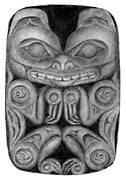 |
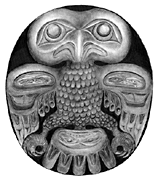 |
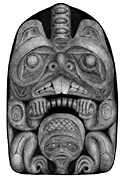 |
| bear | eagle | beaver |
| Illustrations from Haida Monumental Art (1983) | ||
In the 1960s he illustrated "The Raven's Cry" by Christie Harris, a fictionalized narrative of the impact of the arrival of Europeans on Haida society and, particularly, of the history of the Edenshaw family; his aim was to create dynamic representations of elements from the narrative, while using Haida artistic conventions wherever he could. This line of work was extended into drawings with a more textural quality, as though he were drawing wood carvings, beginning with chapter heading illustrations for George MacDonald's landmark book "Haida Monumental Art". These were further developed into a series of pencil drawings for "Raven Steals the Light" (1984), a retelling of several Raven myths, which Reid co-wrote with Robert Bringhurst, who would later write a book about Reid's sculpture "The Spirit of Haida Gwaii." With typical understatement, Reid in his introduction to the book played down its interpretation of the myths as "slight entertainments, mere glancing versions of the grand old tales"; however, their importance lies -- much as his other work -- in bridging the gap between cultures, making the myths very accessible to modern readers.
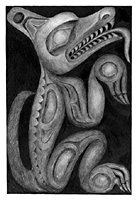 |
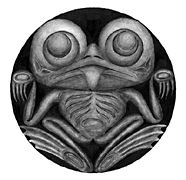 |
| wolf | frog |
| Illustrations from Haida Monumental Art (1983) | |
Even in his writings, his style was wide-ranging. In 1971 he wrote poetic texts to accompany a volume ("Out of the Silence") of Adelaide de Menil's photographs of decaying totem poles. At the other end of the spectrum, the book co-authored with Bill Holm in 1975, "Form and Freedom", was a curatorial assessment of Northwest Coast artworks gathered for an exhibition.
 |
 |
 |